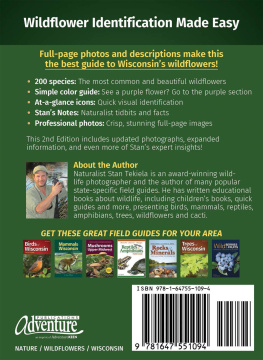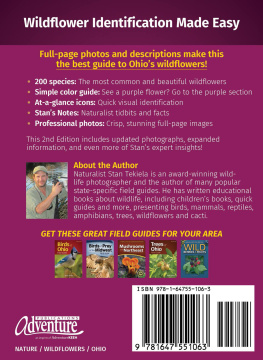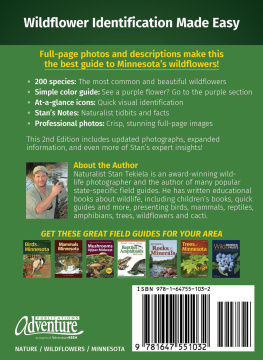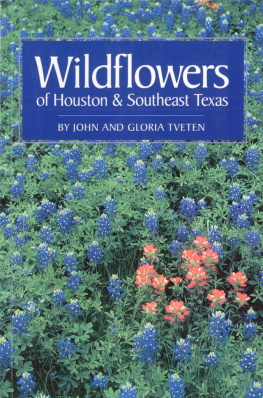Campell Loughmiller - Texas Wildflowers A Field Guide
Here you can read online Campell Loughmiller - Texas Wildflowers A Field Guide full text of the book (entire story) in english for free. Download pdf and epub, get meaning, cover and reviews about this ebook. year: 2018, genre: Home and family. Description of the work, (preface) as well as reviews are available. Best literature library LitArk.com created for fans of good reading and offers a wide selection of genres:
Romance novel
Science fiction
Adventure
Detective
Science
History
Home and family
Prose
Art
Politics
Computer
Non-fiction
Religion
Business
Children
Humor
Choose a favorite category and find really read worthwhile books. Enjoy immersion in the world of imagination, feel the emotions of the characters or learn something new for yourself, make an fascinating discovery.

- Book:Texas Wildflowers A Field Guide
- Author:
- Genre:
- Year:2018
- Rating:3 / 5
- Favourites:Add to favourites
- Your mark:
- 60
- 1
- 2
- 3
- 4
- 5
Texas Wildflowers A Field Guide: summary, description and annotation
We offer to read an annotation, description, summary or preface (depends on what the author of the book "Texas Wildflowers A Field Guide" wrote himself). If you haven't found the necessary information about the book — write in the comments, we will try to find it.
Texas Wildflowers A Field Guide — read online for free the complete book (whole text) full work
Below is the text of the book, divided by pages. System saving the place of the last page read, allows you to conveniently read the book "Texas Wildflowers A Field Guide" online for free, without having to search again every time where you left off. Put a bookmark, and you can go to the page where you finished reading at any time.
Font size:
Interval:
Bookmark:

TEXAS NATURAL HISTORY GUIDES
Texas Wildflowers
A FIELD GUIDE
NEW EDITION
Campbell and Lynn Loughmiller
UPDATED BY
Joe Marcus, Lady Bird Johnson Wildflower Center
FOREWORD TO THE FIRST EDITION BY
Lady Bird Johnson

UNIVERSITY OF TEXAS PRESS
AUSTIN
Copyright 1984, 2006, 2018 by the University of Texas Press
All rights reserved
First edition, 1984
Revised edition, 2006
New edition, 2018
Requests for permission to reproduce material from this work should be sent to:
Permissions
University of Texas Press
P.O. Box 7819
Austin, TX 78713-7819
utpress.utexas.edu/rp-form
Library of Congress Cataloging-in-Publication Data
Names: Loughmiller, Campbell, author. | Loughmiller, Lynn, author. | Marcus, Joe, editor.
Title: Texas wildflowers : a field guide / Campbell and Lynn Loughmiller ; foreword to the first edition by Lady Bird Johnson.
Description: New edition / updated by Joe Marcus, Lady Bird Johnson Wildflower Center. | Austin : University of Texas Press, 2018. | Includes bibliographical references and index.
Identifiers: LCCN 2017008984
ISBN 978-1-4773-1476-0 (pbk. : alk. paper)
ISBN 978-1-4773-1477-7 (library e-book)
ISBN 978-1-4773-1478-4 (non-library e-book)
Subjects: LCSH: Wild flowersTexasIdentification.
Classification: LCC QK188 .L68 2018 | DDC 582.1309764dc23
LC record available at https://lccn.loc.gov/2017008984
doi:10.7560/314760
Contents
by Joe Marcus
by Lady Bird Johnson
by Campbell Loughmiller

Notes on the New Edition
When Campbell and Lynn Loughmiller published the first edition of Texas Wildflowers: A Field Guide in 1984, they gave a wonderful gift to anyone who traveled the highways and byways of Texas and admired the great diversity of natural beauty found along the way. The Loughmillers clear love of Texass flora shone forth both through their stunning photographs and through their homey, conversational descriptions of the species included in the pages of that first edition. My dog-eared copy of that edition is just as valuable to me today as it was then.
Sadly, in the years following the introduction of their field guide to Texass wildflowers, we lost both Campbell and Lynn. But time moves forward, and by 2005 much had changed in our understanding of Texass flora, especially in the area of nomenclature. In short, botanists had changed the names of many Texas wildflowers. Most of those changes were a result of our better understanding of the relationships between species.
Because of the Loughmillers close connection to Lady Bird Johnsonher foreword was published in the first edition and has been included in each edition sinceand to the Lady Bird Johnson Wildflower Center, to whom they donated their botanical image collection, the University of Texas Press turned to the Wildflower Center to edit a new edition. My former boss and mentor, Dr. Damon Waitt, took up the challenge and with skill and the lightest hand possible, brought the book up to date in 2008.
And still, time marches on.
By 2015, botanical nomenclature continued to be in its perpetual state of flux, but also nature lovers were looking for different characteristics in their field guides. So the press asked me to take a swing at revising the book, this time with some structural changes. Somewhat naively perhaps, I accepted.
For those readers familiar with the earlier editions of this field guide, the changes you will find in these pages are not inconsequential. The biggest change is the overall organization of the book. The first two editions were organized by family, then by genus and speciesthe way most botanists would want a book organized. This edition is organized first by flower color, then by flowering time, and finally by genus and species. Our hope is that this new organizational scheme will make the book more useful to novice wildflower enthusiasts by making the identity of their mystery flower easier to find. For those who prefer to search for plants by family name, a family name index is provided in the back of the book.
In moving away from the family-based organization, by necessity we lost the excellent family discussions written by the Loughmillers. I have tried to incorporate as much of that information as possible into the species descriptions in the pages of this book.
This edition also introduces a more formal organizational style for the species descriptions. Each page includes sections for Plant and Leaves, Flowers and Fruit, Flowering, Range and Habitat, and finally, Comments. Many of the comments are excerpted from the Loughmillers original work. Our hope is that this new format will make the information the reader is seeking easier to find.
When travelers find an unknown wildflower on a roadside or along a trail, they typically ask themselves two questions: What plant is that? and What is its story? Early in their travels, the Loughmillers surely asked themselves those very questions, and ultimately the results of their investigations were shared with the world in the pages of that first edition of this field guide.
It is my fondest hope that within the pages of this edition you will find the answer to that first question for some of your unknown Texas wildflowers and will find enough of those plants stories to lead to a deeper and richer understanding and appreciation of Texass remarkable native flora.
I would like to thank the Lady Bird Johnson Wildflower Center for allowing me to work on this project. Also, I am indebted to the many wonderful wildflower photographers who have graciously contributed their work to the Wildflower Centers Native Plant Information Network Image Gallery and have allowed us to also publish them in this field guide. Finally, I wish to give the most heartfelt thank you to Annelia Williams, whose numerous suggestions and excellent organizational skills provided much invaluable assistance in the development of this new edition.
JOE MARCUS
Lady Bird Johnson Wildflower Center
Foreword to the First Edition
I welcome this new field guide for Texas wildflower enthusiasts.
Just reading the text and seeing the beautiful color photographsall 300 of themmakes me want to reach for my sunhat, put on my walking shoes, take this knowledge-filled book, and fare forth to seek and discover!
That is exactly what the authorsCampbell and Lynn Loughmillerhave been doing for forty years. I had the fun of hearing about their wildflower adventures firsthand.
We load our trailer with typewriter, cameras, sunburn lotion, and insect repellent, and we just set out. We dont know where we are heading, and we dont care where we spend the night, the Loughmillers explained.
How wonderful to own your own time and let instinct lead you to the flowerscapes that abide in Texas, from the phlox of South Texas to the wonderful world of cactus in West Texas!
The authors have traveled and photographed hundreds of beautiful field scenes and then knelt down for close-ups of the inhabitants. Selecting the ones for this book from a vast array of color slides was a terrible task, like choosing among your grandchildren, they told me.
Their trails brought them to the University of Texas Press and into publication with this stunning and useful field guide, which has been ably reviewed for technical accuracy by Dr. Lynn Sherrod, botanist at the University of Texas at Tyler.
Next pageFont size:
Interval:
Bookmark:
Similar books «Texas Wildflowers A Field Guide»
Look at similar books to Texas Wildflowers A Field Guide. We have selected literature similar in name and meaning in the hope of providing readers with more options to find new, interesting, not yet read works.
Discussion, reviews of the book Texas Wildflowers A Field Guide and just readers' own opinions. Leave your comments, write what you think about the work, its meaning or the main characters. Specify what exactly you liked and what you didn't like, and why you think so.




